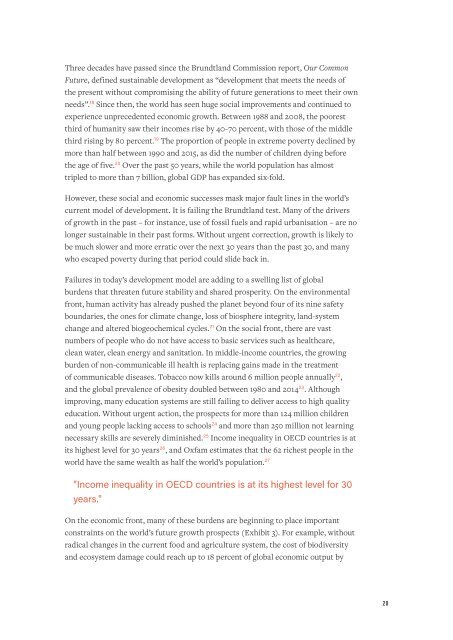BETTER BUSINESS BETTER WORLD
2jxE7K2
2jxE7K2
Create successful ePaper yourself
Turn your PDF publications into a flip-book with our unique Google optimized e-Paper software.
Three decades have passed since the Brundtland Commission report, Our Common<br />
Future, defined sustainable development as “development that meets the needs of<br />
the present without compromising the ability of future generations to meet their own<br />
needs”. 18 Since then, the world has seen huge social improvements and continued to<br />
experience unprecedented economic growth. Between 1988 and 2008, the poorest<br />
third of humanity saw their incomes rise by 40-70 percent, with those of the middle<br />
third rising by 80 percent. 19 The proportion of people in extreme poverty declined by<br />
more than half between 1990 and 2015, as did the number of children dying before<br />
the age of five. 20 Over the past 50 years, while the world population has almost<br />
tripled to more than 7 billion, global GDP has expanded six-fold.<br />
However, these social and economic successes mask major fault lines in the world’s<br />
current model of development. It is failing the Brundtland test. Many of the drivers<br />
of growth in the past – for instance, use of fossil fuels and rapid urbanisation – are no<br />
longer sustainable in their past forms. Without urgent correction, growth is likely to<br />
be much slower and more erratic over the next 30 years than the past 30, and many<br />
who escaped poverty during that period could slide back in.<br />
Failures in today’s development model are adding to a swelling list of global<br />
burdens that threaten future stability and shared prosperity. On the environmental<br />
front, human activity has already pushed the planet beyond four of its nine safety<br />
boundaries, the ones for climate change, loss of biosphere integrity, land-system<br />
change and altered biogeochemical cycles. 21 On the social front, there are vast<br />
numbers of people who do not have access to basic services such as healthcare,<br />
clean water, clean energy and sanitation. In middle-income countries, the growing<br />
burden of non-communicable ill health is replacing gains made in the treatment<br />
of communicable diseases. Tobacco now kills around 6 million people annually 22 ,<br />
and the global prevalence of obesity doubled between 1980 and 2014 23 . Although<br />
improving, many education systems are still failing to deliver access to high quality<br />
education. Without urgent action, the prospects for more than 124 million children<br />
and young people lacking access to schools 24 and more than 250 million not learning<br />
necessary skills are severely diminished. 25 Income inequality in OECD countries is at<br />
its highest level for 30 years 26 , and Oxfam estimates that the 62 richest people in the<br />
world have the same wealth as half the world’s population. 27<br />
"Income inequality in OECD countries is at its highest level for 30<br />
years."<br />
On the economic front, many of these burdens are beginning to place important<br />
constraints on the world’s future growth prospects (Exhibit 3). For example, without<br />
radical changes in the current food and agriculture system, the cost of biodiversity<br />
and ecosystem damage could reach up to 18 percent of global economic output by<br />
20


